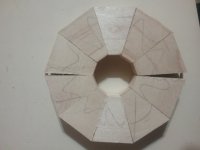Mike,
You are not using the sled correctly. It will be best if you watch a Youtube video as the explanation is easier if you can watch it and, fortunately, there are dozens of videos on the subject.
In a nutshell, you have two boards that form a 'V' that has a precision-made angle for the number of segments you are wanting per row. You take the board you will be cutting the segments from and draw a wavy line on one side of it and here is the key - the wavy line stays face up, you NEVER flip the board over. You place your board on the INSIDE of the V on the fence nearest you and make your first cut. You then move the board to the OUTSIDE of the fence that is furthest from you. Because each of fences are angled, the two cuts make one segment and the second cut becomes the first cut of the next segment.
The science behind this is that the second cut is at a complimentary angle to the first cut. That means that if your first fence is off by one degree, your second cut will also be off that the exact same error. The two errors, when taken together, will equal one perfect angle as long as the two fences have the perfect angle and as long as the fence away from you has two sides that are perfectly parallel. This is true regardless of the orientation of the two fences.
As an added benefit, if your saw blade isn't aligned perpendicular to the table of the saw, it won't make a bit of difference, because the complimentary angle will also correct for a tilted blade.
As you get better at this, you'll start seeing the design capabilities of deliberately putting the two fences out of alignment. What this means is that the edges of the pie-shaped segments will not point to the center as you would normally do with traditional segments. Because the lines are off-center, you can do 'segmented trickery' because the joints made by the straight cuts of the saw will appear to be curved. If they were pointing directly at the center the straight joints will always look to be straight.

